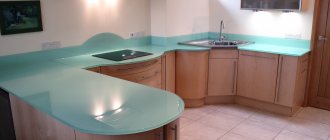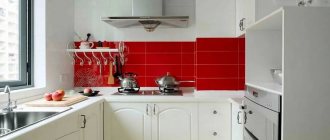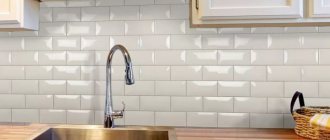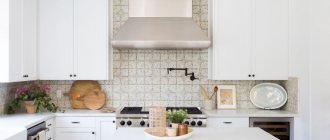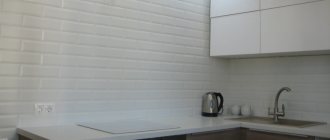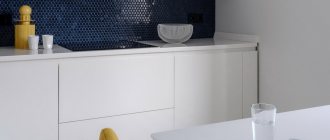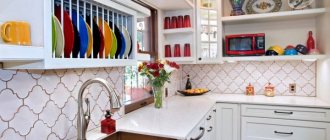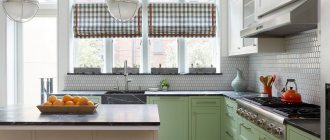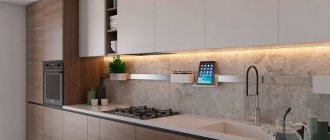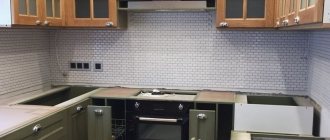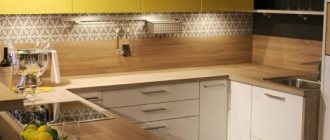A kitchen made in light colors looks fresh and neat. A white kitchen set requires more careful maintenance to maintain a clean and tidy appearance. A kitchen apron can set a certain style for the kitchen. We will introduce you to the most advantageous and fashionable white kitchen design options.
Red work apron in a white kitchen Source dizainvfoto.ru/
How to choose an apron for a white kitchen set
The apron is the part of the kitchen between the top and bottom of the unit; it gets dirty most quickly. During cooking, drops of water, particles of fat, and dust fall on it. It is worth assessing the resistance of the material to cleaning agents, the ability of the surface to reflect light, and the texture of the material. If you rarely cook in the kitchen, you can use almost any materials, but if you plan to prepare food every day, you should choose materials that are easy to clean, because it is quite difficult to achieve a clean glossy or mirror surface.
A kitchen set made in light colors goes well with any color, and by adding decor or dishes to match the apron, you can create a complete interior design.
Black and white kitchen with a bright apron Source www.kuhni-nsk.ru
It is worth deciding on the color scheme, texture, and materials for finishing the kitchen apron in a light kitchen after choosing materials for the walls and floor, as well as the set itself.
When choosing the shade of an apron, you should adhere to the following principles:
- Bright colors can not only get boring quickly, but also increase your appetite.
- Glossy materials make the color rich, while matte materials give the shades a duller appearance.
- A small pattern in a large kitchen can get lost, while a large pattern in a small area can look ridiculous.
- To create a complete kitchen design, you need to choose 2-3 primary colors, which can be diluted with 3-4 additional ones.
It is necessary to choose the material and color of the apron based on the chosen style of the kitchen. Combining several stylistic trends is difficult; not every designer can cope with this task.
A selection of the best photos
For inspiration, look at photo examples of real kitchens:
How do you like the article?
What colors go with a white apron in the kitchen?
The white apron matches any headset tones. But a lot depends on the choice of colors. It happens that the design looks gray and gloomy, or, on the contrary, too bright; not every person can stand the test of staying in such a room for a long time. The most advantageous way is to design in neutral colors and add bright decor.
A white apron matches the white kitchen and brown surface of the work area. You can also choose brown shades for curtains and chairs.
White glossy kitchen with a plain apron Source ko.decorexpro.com
An apron made of white ceramic tiles will suit a pastel or white kitchen. You can complement the interior with a wooden tabletop, chairs, and dining table.
White kitchen with wooden worktop Source www.mitre10.co.nz
A universal version of the kitchen in gray with a white tile apron. This option is neutral; you can refresh and add something new with bright colors, dishes, and furniture. With little effort and money, you can easily change the design of your kitchen.
White work apron Source yandex.ru
Modern design trends allow you to design a kitchen in black tones with a white apron decorated with a pattern. This strict luxurious design can be complemented with decorative elements made of gold. Using the lighting system, the necessary zones are identified.
Rich green color headset Source syndyk.by
Most often, a white apron is combined with a white or gray kitchen.
See also: Catalog of companies that specialize in interior redevelopment.
Backlight
A white apron with lighting looks especially impressive. The most common lighting option is to install lamps with directional light directly above the apron. Such lighting will allow you to illuminate the work area in a directional manner and will not shine into the eyes of those sitting at the table.
White apron with lighting in a white kitchen.
If there are wall cabinets above the apron, then lamps placed on the bottom of the cabinets will be more convenient. It is better to choose LED strip or fluorescent lamps for these purposes - they provide more uniform illumination. Spotlights are too bright and will reflect unattractively on a glossy surface as blinding spots.
Lamps located at the bottom of the cabinets are a convenient placement option.
For glass skinals, the backlight can be of 2 types:
- The LED strip is attached to the top and bottom of the panels. For this, a special aluminum profile with channels for LED strip and wiring is used. The thin and narrow profile does not catch the eye.
- The backlight can be attached to the back of the glass panel, which is moved away from the wall using remote holders. The LED strip is recessed into a niche. This lighting looks very modern - in the form of a clear luminous strip.
A white apron looks most impressive with lighting.
In a modern minimalist kitchen with a white monochrome apron, colored LED lighting with RGB tape - purple, blue, green, red - will look good. Using the remote control, you can control the installation of a dynamic mode with changing colors or other effects, or fixing a specific one color.
Purple LED lighting in the kitchen with a white backsplash.
Pros and cons of a white apron in the kitchen
A white kitchen is a design classic and never goes out of style. Do not forget that white can have shades: ivory, creme brulee, ivory, baked milk.
Light kitchen design has advantages and disadvantages. Advantages of a white apron:
- shades of white are combined with the entire color scheme;
- harmonizes perfectly with any furniture and interior items;
- looks fresh and neat;
- harmonizes with any kitchen;
- relevant at all times;
- visually expands the space.
The only disadvantage of this choice: impracticality; even the slightest dirt will be noticeable on a white apron. Depending on the material from which it is made, you will have to spend time and effort to achieve perfect results. Textured materials are more difficult to clean, although if you regularly maintain cleanliness, difficulties should not arise.
White tiles - a universal option
A white apron creates a feeling of cleanliness, freshness and spaciousness in the interior of even the smallest kitchen. This is part of the stylish monochrome. It structures the space, makes it voluminous and prominent. In a kitchen decorated in any other color, a white apron will be the color accent. It will emphasize bright shades, and make light shades deeper.
The appearance of a snow-white apron is influenced by the choice of material, size and texture of the tiles. The presence of chamfers and the use of decorative inserts attracts the eye. The method of installation, the color of the grout, and the width of the joints also matter. White kitchen tiles can have a glossy or matte surface, a craquelure effect, three-dimensionality, or the rough texture of natural stone.
Which apron to choose for a small kitchen?
A small kitchen does not allow your imagination to run wild. First of all, it is necessary to expand the space in all possible ways: with light-colored materials and light.
For a small area of the room, an apron made of medium-sized beige tiles with a decor with a gold pattern in the center is suitable.
Kitchen apron made of tiles Source moypodval.ru
An excellent option for a compact kitchen is an apron made of white tiles in combination with a white set and a wooden countertop. The apron looks quite interesting due to the shape of the tiles.
Tiles with bricks Source www.doska.ykt.ru
Against the background of a black and white set, a multi-colored apron looks quite festive.
Glass on the kitchen work wall Source psk-remont.ru
You can expand the space of a small kitchen area by using backlight lighting, highlighting the working and dining areas with separate lighting systems.
Work apron made of glass with lighting Source gearbestblog.ru
An apron with a large pattern does not fit into the scale of a small kitchen. At the same time, a small mosaic or pattern will complement the kitchen.
Examples in the interior
You can decorate your work area using white tiles in different ways. We invite you to get acquainted with ready-made solutions that, if necessary, can be used as an idea for subsequent implementation.
Kitchen apron made of tiles
The variety of building materials today allows you to turn any design fantasies into reality. Backsplash tiles are one of the most popular materials. It is durable, not afraid of moisture, chemicals, mechanical stress, and has an affordable price. The only negative is the presence of seams, which need to be renewed every few years.
Features of choosing ceramic tiles for the kitchen:
- For the kitchen, tiles with moisture absorption type A or AA are suitable; this type is more durable and resistant to cleaning agents.
- Relief tiles are difficult to clean.
- Glossy tiles are less resistant to scratches, abrasions and chips than matte ones, but marks and stains are more visible on them.
- The seams of the white tiles will have to be renewed and cleaned.
- The black glossy apron shows splashes, dust particles, and hand marks.
- You need to buy tiles from one batch; the material of different batches may differ slightly.
- In order to have enough material, it is necessary to add 15% to the required amount in case of damage and chipping.
Comparisons with other types of finishes
Instead of tiles, various materials can be used to decorate the apron. The following requirements apply to their characteristics:
- resistance to high temperatures;
- moisture resistance;
- ease of cleaning;
- hygiene;
- beautiful appearance.
The choice can be made in favor of white laminate. It will be possible to form an original surface. But the choice of material should be approached with special responsibility. Most coatings quickly lose their presentability. They are not designed for use in such conditions. You will have to come up with certain methods of protection to make the care process easier.
Metal sheets can also be used to line the work area. However, when choosing this option, you should remember that the smallest droplets will be immediately noticeable. In addition, when using abrasive particles to clean the surface, characteristic defects may appear on the surface of the apron.
Glass kitchen apron
The glass surface of the apron is a good replacement for tiles and panels made from other materials. Glass splashbacks harmonize perfectly with modern styles.
The glass panel complements a light kitchen set of a small area well.
White kitchen with a blue apron Source www.houzz.es
When installing the panel, there is almost no contamination, the panel has no seams, the surface reflects light well, and is easy to clean.
Under the glass you can place any drawing, photograph, wallpaper.
Glass for a kitchen apron is quite expensive; it is not appropriate in all styles; for example, in country or Provence style it is better to use tiles.
The resistance of the material to mechanical stress, moisture and chemicals depends on the type of glass.
Types of glass panels:
- Stalinite (tempered glass) – its resistance to damage is 5-10 times higher than that of ordinary glass. It is resistant to temperature changes and can be installed near the stove.
An apron with a picture of bright tulips harmonizes perfectly with a delicate beige kitchen.
Plastic panel with print Source strangely.ru
- Triplex (laminated glass) consists of several layers connected to each other by a film; the thickness of the glass can be 8 mm. Triplex is more expensive than tempered glass, for this reason it is used less often. For a large kitchen, you can use a triplex panel with such an original pattern.
3-D image Source yandex.ua
- Plexiglas is inexpensive, easy to maintain and install, but it is easily scratched, erased, and becomes dull over time.
Kitchen in cool colors Source dizajnhome.ru
- Polycarbonate is more resistant to temperatures compared to plexiglass, has a greater degree of strength compared to tempered glass, but the material quickly wears out and loses its properties.
A bright single-color polycarbonate panel will make a white kitchen stylish and unique.
Turquoise apron in a white kitchen Source td-universe.com
Relief (or volumetric) tiles
Relief tiles can imitate stucco patterns, brick or stone textures, abstract, floral or geometric patterns.
- Stucco patterns – chic and luxury. This is a suitable option for kitchens in the Empire, Baroque, Classic, Greek, Gothic, Romanesque styles.
- Brick or stone – naturalness and simplicity. Such a kitchen apron will look natural in kitchens in cozy rustic and fashionable modern styles “loft”, “modern”, “techno”, etc.
- Plant patterns – natural beauty: eco-style, Biedermeier, etc.
- Geometric patterns – conciseness and rigor. This design is suitable for a kitchen in Japanese style, “modern”, “minimalism”, etc.
Aprons for the kitchen: all modern ideas and practical tips
In decoration and design, fashion does not stand still. Interesting ideas and new, more sustainable materials are constantly emerging. The design must be decided on the basis of versatility and practicality. A bright kitchen can make an impression, but eventually become so boring that you have to renovate it again.
The apron should be located around the entire perimeter of the kitchen, not only in the most contaminated places, behind the sink and stove. If the kitchen sink is in a corner, an apron should protect it on both sides.
Corner set in a small kitchen Source www.pinterest.com
Mosaic apron: unique charm
Creating a mosaic panel above the work area and sink means making the kitchen amazingly beautiful and original. Even a monochrome white mosaic design will look elegant and unusual.
Mosaic can be made from a variety of materials:
- Ceramics;
- Glass;
- Mirror;
- Smalt (painted opaque glass), etc.
Such an exquisite backsplash design will be appropriate in kitchens in the style of “eclectic”, “retro” and “high-tech” (mirror tiles), ethnic (patterns of light mosaics of different shades), etc.
New tile designs
In an effort to attract more attention, manufacturers regularly come up with new solutions that will help you look at the interior differently.
Fresh designs are often fashion-oriented and impossible to ignore. Every new product is sure to find its buyers. The greatest attention is focused on various imitations.
Wood effect ceramics
The increased demand for eco style and environmental themes in the context of nature conservation and unity with it leads to the creation of familiar materials that imitate natural raw materials.
- This happened with ceramic tiles. The wooden design proved popular.
- Tiles of this appearance are used for cladding various surfaces.
- It will perfectly replace parquet flooring. Wood-effect tiles can be used to decorate an accent wall.
This option will look good as an apron in the work area. Manufacturers offer designs that imitate various types of wood. The option is more practical than natural wood. It looks solid and respectable, no worse than its natural prototype.
Stone effect tiles
Along with wood-look tiles, a material imitating stone has appeared. This can be either a decoy or the actual use of natural raw materials for the production of finishing materials.
- At the same time, imitation is sometimes no worse than natural prototypes. It is not always possible to distinguish stone-look tiles from marble, slate, and granite.
- This option looks most advantageous in a classic or rustic style interior.
The antique material deserves special attention. This is an imitation of stone with chips, abrasions and irregularities.
Brick imitation
Another popular solution would be to use brick tiles in the kitchen. This is an option for wall decoration. These tiles can be used to cover the entire kitchen or make an accent in the interior.
- Brick tiles are used in both light and dark colors.
- The placement on the wall often imitates real brickwork.
- The option is appropriate in different styles. White brick tiles look most successful in a Scandinavian interior.
- Dark imitation will fit well into the Loft style design.
Parallel with fabric
An extraordinary choice for finishing a kitchen would be tiles made to look like fabric. This can be an imitation of any type of textile.
Particularly popular are:
- Jute;
- Matting;
- Jeans;
- Canvas;
- Tapestry.
This trend is inspired by the theme of ecology. I want to decorate the room with practical materials, but in the spirit of fashionable style. Often the imitation of fabric on tiles is so realistic that you can only understand the replacement by touch.
Phototile
Photo tiles are beyond competition. This is amazingly alluring material. With its help it is easy to create a wonderful environment.
- Photo tiles are often used to decorate an accent wall.
- It becomes a picture that creates a mood.
- Such an element in the interior helps to expand the space.
Photo tiles can be present on the apron, acting as the basis or addition to the design. On the floor, such a solution will rarely be found, but nothing is impossible.
Caring for a matte kitchen
A matte kitchen can last for many years if you care for it properly. The rules for caring for facades depend on the material of manufacture, but to ensure that the surface does not lose its matte effect, the following nuances must be taken into account:
- Only special products and solutions should be used to clean surfaces. Avoid compositions containing alcohol and abrasives - they can cause facades to fade.
- If the set is made of solid wood, dirt and stains can be removed using a steam generator.
- The surface must be wiped with soft, lint-free cloths, microfiber or paper towels. Do not use hard sponges or brushes for this, otherwise scratches will appear on the facades.
- If a greasy stain appears on the headset, it must be wiped off immediately. If this is not done in time, the fat will be absorbed into the surface and will be difficult to remove.
- Do not leave facades wet: always wipe them dry after cleaning.
Selecting tile size
Which format is best for the kitchen? Let's start by studying the layout and size of the kitchen. Let's try to choose a tile size that will allow us to make as few cuts as possible.
If the kitchen is connected to the living room, we will begin laying the tiles from the point of contact with the panel or wooden floor.
You need to plan the placement of the tiles so that the cuts are in less noticeable places, for example, under kitchen furniture.
When choosing the size of the tiles, consider the layout of the kitchen. For rectangular interiors, large tiles will look best.
You can often hear the opinion that in small kitchens you need to install smaller tiles. But the small format means more joints. Larger format tiles using a minimum amount of grout create a uniform surface.
Advantages and disadvantages of tiles
Tiles made of ceramics or natural stone are considered a universal material for the kitchen; they have a wide range of color options and will suit any design solution.
Advantages:
- long service life;
- resistance to deformation;
- environmental friendliness;
- resistance to abrasion and minor damage;
- fire resistance;
- moisture resistance;
- easy to clean with any detergent.
Flaws:
- cold surface;
- low noise insulation;
- fragility when hit by a heavy object.
Color range of tiles for khuni
There is simply no color that is impossible for tiles. A large palette of colors will allow you to choose a material to suit every taste:
- Bright hues. Ideal for small spaces and studios.
- Dark shades. Used to create a contrasting wall or highlight a white set.
Colored or patterned tiles will be a nice addition to rural styles, a strict monochromatic finish is suitable for minimalist designs, geometric shapes will add more dynamism to modern interiors.
Laying tiles diagonally
Options for laying floor tiles with a seam are divided according to the installation method.
There are three main ones:
- Seam to seam;
- In the dressing;
- Diagonally.
- The first one can be called classic. The tiles form rows in horizontal and vertical directions.
- The second involves pairing the tiles like a “brickwork” bond.
- And with the third, seams are formed in diagonal directions at an angle of 45 degrees relative to the walls.
